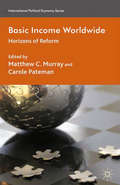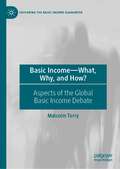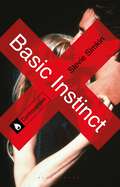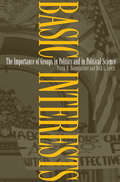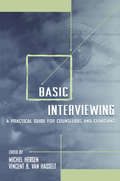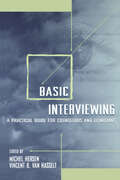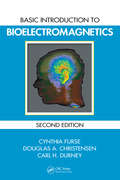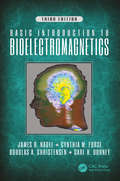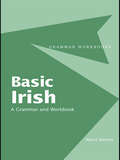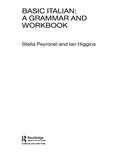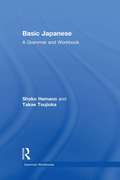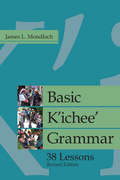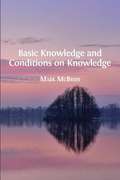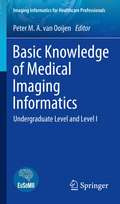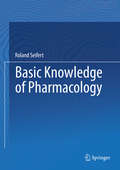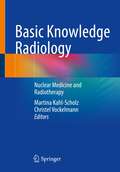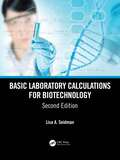- Table View
- List View
Basic Income Worldwide: Horizons of Reform (International Political Economy Series)
by Matthew C. Murray Carole PatemanIn the midst of growing criticism of current economic orthodoxies and welfare systems, basic income is growing in popularity. This is the first book to discuss existing at examples of basic income, in both rich and poor countries, and to consider its prospects in other places around the world.
Basic Income—What, Why, and How?: Aspects of the Global Basic Income Debate (Exploring the Basic Income Guarantee)
by Malcolm TorryThe global Basic Income debate is now widespread, diverse, and relatively well resourced by academic and more popular literature: but that does not mean that there is universal agreement about every topic of discussion. In fact, there is still a quite heated debate about some of the most basic questions, such as ‘What is a Basic Income?’ ‘What’s the point?’, and ‘Is it feasible?’This book is not yet another general introduction to Basic Income. There are already plenty of those. It is entirely about those aspects of the debate about which there is most discussion and sometimes the most conflict. It is based on conference papers, previously published chapters, and other previously published articles, working papers, and reports: material that has already benefited from consultation and debate, as is appropriate for a book about aspects of a debate that are the subject of frequent consultation and discussion.
Basic Instinct (Controversies)
by Stevie SimkinPaul Verhoeven's 1992 thriller Basic Instinct - starring Michael Douglas as a police detective and Sharon Stone as the femme fatale Catherine Tramell - was one of the first mainstream 'erotic thrillers', a film which shifted the boundaries for graphic representations of sex in Hollywood cinema. It remains a significant milestone in film censorship and controversy. In his fascinating study, the first in-depth account of the film, Stevie Simkin explores the unrest and protest that Basic Instinct sparked in the gay, lesbian and feminist communities in the US, incensed by what they saw as the script's homophobia and misogyny.Simkin considers the social and cultural context in which Basic Instinct was made, examining the film's troubled production history, the battles with censors, and its reception. He offers a number of readings of the movie, looking at its representation of bisexuality and the depiction of a 'transgressive' female protagonist. He also focuses on key sequences, including the infamous interrogation scene, and details the cuts demanded by the censors, resulting in different UK and US versions. In conclusion, Simkin considers the legacy of Basic Instinct, and its enduring effect on media representations of the violent woman.STEVIE SIMKIN is Reader in Drama and Film at the University of Winchester, UK. His publications include work on cult television, popular music, and Renaissance drama. He is the author of, amongst other works, A Preface to Marlowe (1999), Revenge Tragedy: A New Casebook (2001), Early Modern Tragedy and the Cinema of Violence (2005), and, also in the Controversies series, a book on the Peckinpah film, Straw Dogs.
Basic Interests: The Importance of Groups in Politics and in Political Science (PDF)
by Frank R. Baumgartner Beth L. LeechA generation ago, scholars saw interest groups as the single most important element in the American political system. Today, political scientists are more likely to see groups as a marginal influence compared to institutions such as Congress, the presidency, and the judiciary. Frank Baumgartner and Beth Leech show that scholars have veered from one extreme to another not because of changes in the political system, but because of changes in political science. They review hundreds of books and articles about interest groups from the 1940s to today; examine the methodological and conceptual problems that have beset the field; and suggest research strategies to return interest-group studies to a position of greater relevance. The authors begin by explaining how the group approach to politics became dominant forty years ago in reaction to the constitutional-legal approach that preceded it. They show how it fell into decline in the 1970s as scholars ignored the impact of groups on government to focus on more quantifiable but narrower subjects, such as collective-action dilemmas and the dynamics of recruitment. As a result, despite intense research activity, we still know very little about how groups influence day-to-day governing. Baumgartner and Leech argue that scholars need to develop a more coherent set of research questions, focus on large-scale studies, and pay more attention to the context of group behavior. Their book will give new impetus and direction to a field that has been in the academic wilderness too long.
Basic Interests: The Importance of Groups in Politics and in Political Science
by Frank R. Baumgartner Beth L. LeechA generation ago, scholars saw interest groups as the single most important element in the American political system. Today, political scientists are more likely to see groups as a marginal influence compared to institutions such as Congress, the presidency, and the judiciary. Frank Baumgartner and Beth Leech show that scholars have veered from one extreme to another not because of changes in the political system, but because of changes in political science. They review hundreds of books and articles about interest groups from the 1940s to today; examine the methodological and conceptual problems that have beset the field; and suggest research strategies to return interest-group studies to a position of greater relevance. The authors begin by explaining how the group approach to politics became dominant forty years ago in reaction to the constitutional-legal approach that preceded it. They show how it fell into decline in the 1970s as scholars ignored the impact of groups on government to focus on more quantifiable but narrower subjects, such as collective-action dilemmas and the dynamics of recruitment. As a result, despite intense research activity, we still know very little about how groups influence day-to-day governing. Baumgartner and Leech argue that scholars need to develop a more coherent set of research questions, focus on large-scale studies, and pay more attention to the context of group behavior. Their book will give new impetus and direction to a field that has been in the academic wilderness too long.
Basic Interviewing: A Practical Guide for Counselors and Clinicians
by Michel Hersen Vincent B. Van HasseltThis book offers clear and direct answers to the questions most frequently asked by students and trainees learning how to talk to clients and extract critical data from them. Its development reflects the old adage that "necessity is the mother of invention." For many years, the editors taught beginning level mental health clinicians. They found, however, no text to be satisfactory--including a number that they themselves were involved in producing. Some were too difficult; some were too simplistic; some were too doctrinaire; still others had missing elements. Written in a reader-friendly "how-to" style, the chapters in Basic Interviewing are not weighed down by references. Rather, each contributor suggests readings for students and instructors who wish to pursue questions further. After the initial overview chapter, there are 12 chapters addressing the nuts-and-bolts concerns of all clinicians that can be particularly vexing for neophytes. They cover a variety of issues from the most specific--like how to begin and end interviews--to the more general--like how to build rapport and identify targets for treatment. Throughout, rich clinical illustrations facilitate the pragmatic application of fundamental principles. Beginning graduate students in counseling and clinical psychology, social work, and other allied mental health fields, as well as psychiatric trainees, will find this text to be an indispensable companion.
Basic Interviewing: A Practical Guide for Counselors and Clinicians
by Michel Hersen Vincent B. Van HasseltThis book offers clear and direct answers to the questions most frequently asked by students and trainees learning how to talk to clients and extract critical data from them. Its development reflects the old adage that "necessity is the mother of invention." For many years, the editors taught beginning level mental health clinicians. They found, however, no text to be satisfactory--including a number that they themselves were involved in producing. Some were too difficult; some were too simplistic; some were too doctrinaire; still others had missing elements. Written in a reader-friendly "how-to" style, the chapters in Basic Interviewing are not weighed down by references. Rather, each contributor suggests readings for students and instructors who wish to pursue questions further. After the initial overview chapter, there are 12 chapters addressing the nuts-and-bolts concerns of all clinicians that can be particularly vexing for neophytes. They cover a variety of issues from the most specific--like how to begin and end interviews--to the more general--like how to build rapport and identify targets for treatment. Throughout, rich clinical illustrations facilitate the pragmatic application of fundamental principles. Beginning graduate students in counseling and clinical psychology, social work, and other allied mental health fields, as well as psychiatric trainees, will find this text to be an indispensable companion.
Basic Introduction to Bioelectromagnetics
by Cynthia Furse Douglas A. Christensen Carl H. DurneyAlthough classical electromagnetic (EM) field theory is typically embedded in vector calculus and differential equations, many of the basic concepts and characteristics can be understood with precursory mathematical knowledge. Completely revised and updated, Basic Introduction to Bioelectromagnetics, Second Edition facilitates the process of interd
Basic Introduction to Bioelectromagnetics, Third Edition
by Cynthia Furse Douglas A. Christensen Carl H. Durney James NagelBasic Introduction to Bioelectromagnetics, Third Edition, is a primary source for medical technologists and life scientists seeking to understand how electromagnetic fields interact with the body, and how they are used in medical applications. Instead of the complex math commonly used when analyzing electromagnetics, this book uses graphical methods and simple equations. The third edition is updated with color graphics that show the fields in bright, clear colors. Each concept is presented with an associated discussion and application, including MRI, NMR, hyperthermia, neural stimulation, ultrasound, and cardiac pacing/defibrillation. Offering a simplified explanation of a very complex subject, this third edition provides an accessible introduction for life scientists and medical technologist on how EM fields work, what controls them, and the factors important to experimental setups and medical applications. This qualitative and illustrative book: Covers the entire frequency spectrum from direct current (DC) up through optical frequencies. Includes more than 200 illustrations, 65 in color, and 40 medical applications. Incorporates examples from real-world applications to explain concepts. Concentrates on the qualitative explanation of the key concepts, fundamental principles, and characteristic behaviors of EM fields, without complicated mathematics. Offers practical rules of thumb to understand real situations. Requires only a background in algebra, in contrast to typical EM books that require vector calculus and differential equations.
Basic Introduction to Bioelectromagnetics, Third Edition
by Cynthia Furse Douglas A. Christensen Carl H. Durney James NagelBasic Introduction to Bioelectromagnetics, Third Edition, is a primary source for medical technologists and life scientists seeking to understand how electromagnetic fields interact with the body, and how they are used in medical applications. Instead of the complex math commonly used when analyzing electromagnetics, this book uses graphical methods and simple equations. The third edition is updated with color graphics that show the fields in bright, clear colors. Each concept is presented with an associated discussion and application, including MRI, NMR, hyperthermia, neural stimulation, ultrasound, and cardiac pacing/defibrillation. Offering a simplified explanation of a very complex subject, this third edition provides an accessible introduction for life scientists and medical technologist on how EM fields work, what controls them, and the factors important to experimental setups and medical applications. This qualitative and illustrative book: Covers the entire frequency spectrum from direct current (DC) up through optical frequencies. Includes more than 200 illustrations, 65 in color, and 40 medical applications. Incorporates examples from real-world applications to explain concepts. Concentrates on the qualitative explanation of the key concepts, fundamental principles, and characteristic behaviors of EM fields, without complicated mathematics. Offers practical rules of thumb to understand real situations. Requires only a background in algebra, in contrast to typical EM books that require vector calculus and differential equations.
Basic Irish: A Grammar and Workbook (Grammar Workbooks)
by Nancy StensonBasic Irish: A Grammar and Workbook provides a jargon-free introduction to the most commonly used grammatical structures within the Irish language. Focusing on the repeated use of grammatical patterns, this Workbook develops an understanding of the structures presented, making the forms familiar and automatic for learners. This user-friendly workbook includes: terminology introduced and explained with multiple examples exercises in the grammatical forms introduced in the text translation exercises an exercise key.
Basic Irish: A Grammar and Workbook (Grammar Workbooks)
by Nancy StensonBasic Irish: A Grammar and Workbook provides a jargon-free introduction to the most commonly used grammatical structures within the Irish language. Focusing on the repeated use of grammatical patterns, this Workbook develops an understanding of the structures presented, making the forms familiar and automatic for learners. This user-friendly workbook includes: terminology introduced and explained with multiple examples exercises in the grammatical forms introduced in the text translation exercises an exercise key.
Basic Italian: A Grammar and Workbook (Grammar Workbooks)
by Stella Peyronnel Ian HigginsIntroducing Italian culture and people through the medium of the language used today, Basic Italian: A Grammar and Workbook provides readers with the basic tools to express themselves in a wide variety of situations. Presenting twenty-three individual grammar points in lively and realistic contexts, Basic Italian is an accessible reference grammar with related exercises in one, easy to follow volume. Each unit consists of jargon-free explanations and comparisons with English, which focus upon the more common difficulties experienced by learners of Italian. Features include: * contemporary examples in both Italian and English * grammar tables for easy reference * full exercise answer key * glossary of grammatical terms. Basic Italian is the ideal reference and practice book for beginners, as well as for students with some knowledge of the language.
Basic Italian: A Grammar and Workbook (Grammar Workbooks)
by Stella Peyronnel Ian HigginsIntroducing Italian culture and people through the medium of the language used today, Basic Italian: A Grammar and Workbook provides readers with the basic tools to express themselves in a wide variety of situations. Presenting twenty-three individual grammar points in lively and realistic contexts, Basic Italian is an accessible reference grammar with related exercises in one, easy to follow volume. Each unit consists of jargon-free explanations and comparisons with English, which focus upon the more common difficulties experienced by learners of Italian. Features include: * contemporary examples in both Italian and English * grammar tables for easy reference * full exercise answer key * glossary of grammatical terms. Basic Italian is the ideal reference and practice book for beginners, as well as for students with some knowledge of the language.
Basic Japanese: A Grammar and Workbook
by Shoko Hamano Takae TsujiokaBasic Japanese: A Grammar and Workbook comprises an accessible reference grammar and related exercises in a single volume.This book presents 25 individual grammar points, covering the core material which students would expect to encounter in their first year of learning Japanese. Divided into two parts, the first part outlines fundamental components of Japanese including the writing system, pronunciation, word order, particles and conjugation patterns, while the second part builds on this foundation by introducing basic grammatical patterns organised by the task they achieve. Grammar points are followed by contextualised examples and exercises which allow students to reinforce and consolidate their learning. Key features include: clear, accessible format many useful language examples transliteration of all examples jargon-free explanations of grammar abundant exercises with full answer key subject index. Basic Japanese is suitable both for class use and independent study making it an ideal grammar reference and practice resource for both beginners and students with some knowledge of the language.
Basic Japanese: A Grammar and Workbook
by Shoko Hamano Takae TsujiokaBasic Japanese: A Grammar and Workbook comprises an accessible reference grammar and related exercises in a single volume.This book presents 25 individual grammar points, covering the core material which students would expect to encounter in their first year of learning Japanese. Divided into two parts, the first part outlines fundamental components of Japanese including the writing system, pronunciation, word order, particles and conjugation patterns, while the second part builds on this foundation by introducing basic grammatical patterns organised by the task they achieve. Grammar points are followed by contextualised examples and exercises which allow students to reinforce and consolidate their learning. Key features include: clear, accessible format many useful language examples transliteration of all examples jargon-free explanations of grammar abundant exercises with full answer key subject index. Basic Japanese is suitable both for class use and independent study making it an ideal grammar reference and practice resource for both beginners and students with some knowledge of the language.
Basic K'ichee' Grammar: 38 Lessons, Revised Edition (IMS Monograph Series)
by James L. MondlochThe K’ichee’an languages—K’ichee’, Kaqchikel, Tz¢utujil, Sakapulteko, Achi, and Sipakapense—occupy a prominent place among the indigenous languages of the Americas because of both their historical significance and the number of speakers (more than one million total). Basic K'ichee' Grammar is an extensive and accurate survey of the principal grammatical structures of K’ichee’. Written in a clear, nontechnical style to facilitate the learning of the language, it is the only K’ichee’ grammar available in English. A pedagogical rather than a reference grammar, the book is a thorough presentation of the basics of the K’ichee’ Maya language organized around graded grammatical lessons accompanied by drills and exercises. Author James L. Mondloch spent ten years in K’ichee’-speaking communities and provides a complete analysis of the K’ichee’ verb system based on the everyday speech of the people and using a wealth of examples and detailed commentaries on actual usage. A guide for learning the K’ichee’ language, Basic K'ichee' Grammar is a valuable resource for anyone seeking a speaking and reading knowledge of modern K’ichee’, including linguists, anthropologists, and art historians, as well as nonacademics working in K’ichee’ communities, such as physicians, dentists, community development workers, and educators.
Basic Knowledge and Conditions on Knowledge
by Mark McBrideHow do we know what we know? In this stimulating and rigorous book, Mark McBride explores two sets of issues in contemporary epistemology: the problems that warrant transmission poses for the category of basic knowledge; and the status of conclusive reasons, sensitivity, and safety as conditions that are necessary for knowledge. To have basic knowledge is to know (have justification for) some proposition immediately, i.e., knowledge (justification) that doesn’t depend on justification for any other proposition. This book considers several puzzles that arise when you take seriously the possibility that we can have basic knowledge. McBride’s analysis draws together two vital strands in contemporary epistemology that are usually treated in isolation from each other. Additionally, its innovative arguments include a new application of the safety condition to the law. This book will be of interest to epistemologists―both professionals and students.
Basic Knowledge and Conditions on Knowledge
by Mark McBrideHow do we know what we know? In this stimulating and rigorous book, Mark McBride explores two sets of issues in contemporary epistemology: the problems that warrant transmission poses for the category of basic knowledge; and the status of conclusive reasons, sensitivity, and safety as conditions that are necessary for knowledge. To have basic knowledge is to know (have justification for) some proposition immediately, i.e., knowledge (justification) that doesn’t depend on justification for any other proposition. This book considers several puzzles that arise when you take seriously the possibility that we can have basic knowledge. McBride’s analysis draws together two vital strands in contemporary epistemology that are usually treated in isolation from each other. Additionally, its innovative arguments include a new application of the safety condition to the law. This book will be of interest to epistemologists―both professionals and students.
Basic Knowledge and Conditions on Knowledge (PDF)
by Mark McBrideHow do we know what we know? In this stimulating and rigorous book, Mark McBride explores two sets of issues in contemporary epistemology: the problems that warrant transmission poses for the category of basic knowledge; and the status of conclusive reasons, sensitivity, and safety as conditions that are necessary for knowledge. To have basic knowledge is to know (have justification for) some proposition immediately, i.e., knowledge (justification) that doesn’t depend on justification for any other proposition. This book considers several puzzles that arise when you take seriously the possibility that we can have basic knowledge. McBride’s analysis draws together two vital strands in contemporary epistemology that are usually treated in isolation from each other. Additionally, its innovative arguments include a new application of the safety condition to the law. This book will be of interest to epistemologists―both professionals and students.
Basic Knowledge of Medical Imaging Informatics: Undergraduate Level and Level I (Imaging Informatics for Healthcare Professionals)
by Peter M. A. van OoijenThis book provides a unique introduction to the vast field of Medical Imaging Informatics for students and physicians by depicting the basics of the different areas in Radiology Informatics. It features short chapters on the different main areas in Medical Imaging Informatics, such as Picture Archiving and Communication Systems (PACS), radiology reporting, data sharing, and de-identification and anonymization, as well as standards like Digital Imaging and Communications in Medicine (DICOM), Integrating the Health Enterprise (IHE) and Health Level 7 (HL7,. Written by experts in the respective fields and endorsed by the European Society of Medical Imaging Informatics (EuSoMII) the scope of the book is based on the Medical Imaging Informatics sub-sections of the European Society of Radiology (ESR) European Training Curriculum Undergraduate Level and Level I. This volume will be an invaluable resource for residents and radiologists and is also specifically suited for undergraduate training.
Basic Knowledge of Pharmacology
by Roland SeifertThis is the perfect pharmacology textbook for medical and pharmacy students. The book was developed on the +30-year experience of the author as pharmacology professor in the United States and Germany. The book discusses the most important drugs (400) in the context of relevant diseases. Summary tables and schemes, MCQ exam questions, case studies and a list of drugs aid memorization of the material before an exam. All chapters are written in the same concise style and use a modern and precise pharmacological nomenclature. After reading of the book, the student will be able to critically assess the proper use of the most important drugs and advise patients properly. The didactic concept of the book has been developed on the author’s own pharmacology courses for which he has received numerous teaching awards. The book takes advantage of the learning spiral, in which material is presented repeatedly from various angles. This book is an adaptation for an international audience of the German textbook “Basiswissen Pharmakologie” (2018); ISBN: 978-3-662-56303-8.
Basic Knowledge Radiology: Nuclear Medicine and Radiotherapy With 215 Illustrations
by Martina Kahl-Scholz Christel VockelmannClear and compact, this textbook provides you with a complete overview of all radiology content relevant to the exam. It guides you in an easy-to-understand and GK-oriented manner through the entire basic knowledge from the fundamentals to the most important clinical pictures, including nuclear medicine and radiation therapy. Benefit from the many years of experience of the lecturers, who have carefully selected and prepared the essentials for you.
Basic Laboratory Calculations for Biotechnology
by Lisa A. SeidmanTo succeed in the lab, it is crucial to be comfortable with the math calculations that are part of everyday work. This accessible introduction to common laboratory techniques focuses on the basics, helping even readers with good math skills to practice the most frequently encountered types of problems. Basic Laboratory Calculations for Biotechnology, Second Edition discusses very common laboratory problems, all applied to real situations. It explores multiple strategies for solving problems for a better understanding of the underlying math. Primarily organized around laboratory applications, the book begins with more general topics and moves into more specific biotechnology laboratory techniques at the end. This book features hundreds of practice problems, all with solutions and many with boxed, complete explanations; plus hundreds of "story problems" relating to real situations in the lab. Additional features include: Discusses common laboratory problems with all material applied to real situations Presents multiple strategies for solving problems help students to better understand the underlying math Provides hundreds of practice problems and their solutions Enables students to complete the material in a self-paced course structure with little teacher assistance Includes hundreds of "story problems"that relate to real situations encountered in the laboratory
Basic Laboratory Calculations for Biotechnology
by Lisa A. SeidmanTo succeed in the lab, it is crucial to be comfortable with the math calculations that are part of everyday work. This accessible introduction to common laboratory techniques focuses on the basics, helping even readers with good math skills to practice the most frequently encountered types of problems. Basic Laboratory Calculations for Biotechnology, Second Edition discusses very common laboratory problems, all applied to real situations. It explores multiple strategies for solving problems for a better understanding of the underlying math. Primarily organized around laboratory applications, the book begins with more general topics and moves into more specific biotechnology laboratory techniques at the end. This book features hundreds of practice problems, all with solutions and many with boxed, complete explanations; plus hundreds of "story problems" relating to real situations in the lab. Additional features include: Discusses common laboratory problems with all material applied to real situations Presents multiple strategies for solving problems help students to better understand the underlying math Provides hundreds of practice problems and their solutions Enables students to complete the material in a self-paced course structure with little teacher assistance Includes hundreds of "story problems"that relate to real situations encountered in the laboratory
